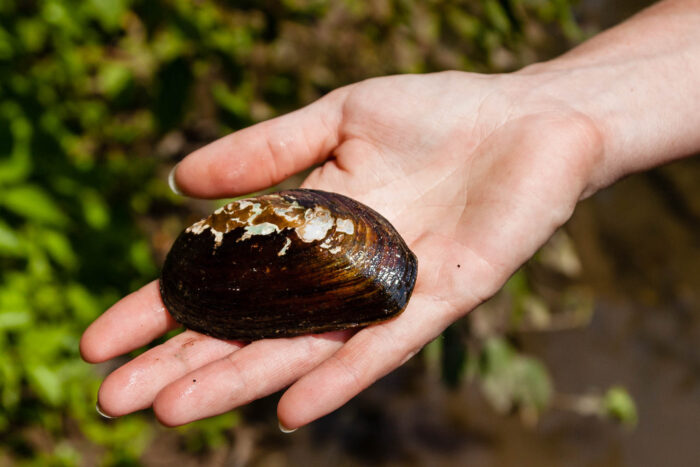Eastern elliptio
Elliptio complanata
The eastern elliptio is a freshwater mussel that can be found throughout the Chesapeake watershed.
This section shows one large critter image at a time. Use the thumbnails that follow to select a specific image to display here.

This gallery contains a grid of small thumbnails. Selecting a thumbnail will change the main image in the preceding section.
Appearance
The eastern elliptio is an important mussel that filters nutrients and sediments from the water and are food source for many species. The mussel is typically oval or trapezoidal with a brown or dark green shell and grow to four to five inches in length.
Feeding
Mussels like the eastern elliptio are filter feeders. They take in water, trap any particles in a lining of mucus, then sort food particles and direct them toward the mouth. Food includes algae, bacteria and various plankton.
Predators
Mammals, like raccoons, otters, muskrats and minks, and some bird species prey on this mussel. Some fish may also eat juveniles.
Reproduction and life cycle
Eastern elliptio mussels reproduce through open fertilization, where the males release sperm into the water around them and the females take it in as they take in water. The eggs become fertilized and are brooded in the mussel’s water tubes, or marsupia, for up to a month while they develop into glochidia, the larval stage. The glochidia are released into the water, where they find a host fish and attach to their gills.
Host fish species include American eel, yellow perch, brook trout, lake trout, mottled sculpin and slimy sculpin. Within a couple hours, the larvae are encapsulated by the host fish’s body. In the following days or weeks, the glochidia metamorphose into juvenile mussels, about the size of a grain of sand, at which point they fall of the host and attach to the substrate. Established eastern elliptio mussels can live for decades.
Did you know?
- Eastern Elliptio are almost always found in streams where the American eel, one of their host species, is also found. The need relatively clean water to survive, so its presence is a good indicator of environmental health.
- An adult mussel can filter and clean about 10 gallons of water each day.
- Mussel restoration projects are underway in various areas of the Chesapeake Bay watershed to reestablish populations and take advantage of their water-cleaning abilities.
- The eastern elliptio is the most common of Maryland’s 16 native mussel species, though its populations are much lower than they once were.
- The name elliptio refers to the elliptical shape of the mussel’s shell.
Sources and additional information
- Animal Diversity Web: Elliptio complanata – University of Michigan
- Eastern elliptio – Maryland Department of Natural Resources
- Newly Documented Host Fishes for the Eastern Elliptio Mussel Elliptio complanate – Journal of Fish and Wildlife Management
- Maryland begins program to replenish freshwater mussels – The Washington Post
